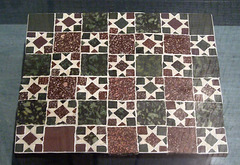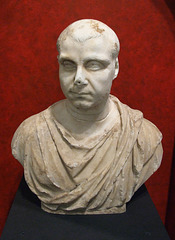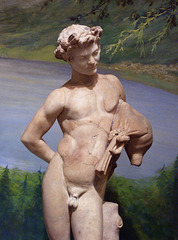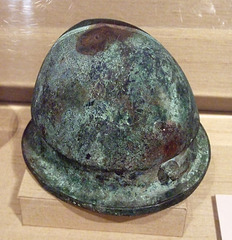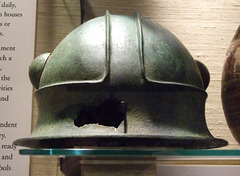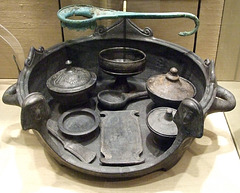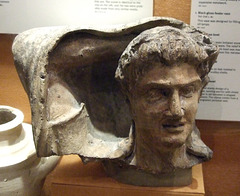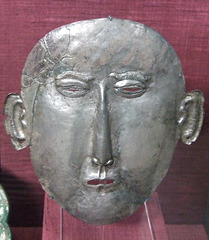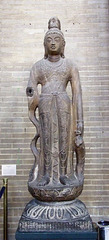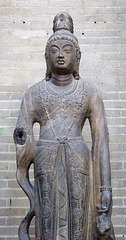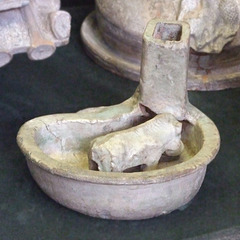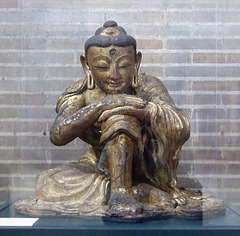LaurieAnnie's photos
Opus Alexandrinum Mosaic in the University of Penn…
| |
|
Opus Alexandrinum Mosaic
Rome
4th century AD
# MS 4014
This flooring is made up of thin squares of red and green porphyry and slivers of white marble set to create a roughly checkerboard effect. This technique is called Opus Alexandrinum.
Text from the U. Penn. Museum label.
and
Mosaic Flooring
Mosaic flooring, the decorative equivalent of carpeting, was in near universal use throughout the Roman Empire. The Romans took the concept from the Greeks who made mosaics of carefully selected natural pebbles. In the 3rd- 2nd centuries BC this art form was modified through the use of tesserae- stones, glass, or glazed terracotta cubes cut to uniform sizes. Tessellated mosaics became the norm in the Roman period.
The fragments shown here illustrate several techniques of Roman mosaic.
Text from the U. Penn. Museum wall plaque.
Attic Pentelic Marble Grave Stele in the Universit…
| |
|
Attic Pentelic Marble Grave Stele
ca. 350-300 BC
# MS 5470
The stele here is treated as an architecturalized niche, framed by pilasters, a lintel and an architrave carrying a flat tiled roof. Two men stand by a seated woman named Krinylla, daughter of Stratios, according to the epitaph still faintly visible on the architrave. The bearded man in the center is Naukles, son of Naukrates of Lamptrae, while the man on the right is Naukrates, son of Naukles of Lamptrae. The second Naukles must be the grandfather of the first. Lamptrae was a district or deme of Attica.
Text from the U. Penn. Museum label
Marble Funeral Portrait of a Middle-Aged Man in th…
| |
|
Marble Funeral Portrait of a Middle-Aged Man
AD 240
# MS-250
The back of the head is summarily carved and the scale of this portrait is less than life-size. This suggests that the piece was displayed in a shallow niche inside a communal tomb known as a columbarium (dovecote), used for housing the cremated remains of the dead.
Text from the U. Penn. Museum label.
Faun with a Wineskin in the University of Pennsylv…
| |
|
Faun with Wineskin
1st century BC- 1st century AD
# MS-3452
A pastiche of ancient sculpture fragments and 19th century restorations, this statuette comprises as many as five different kinds of marble.
Text from the U. Penn. Museum label
Etruscan Jockey Cap Helmet in the University of Pe…
| |
|
Bronze Jockey-type Helmet
4th century BC
# MS 1606
The design of this Etruscan helmet with cheek protectors was taken over from the Gauls during the 4th century BC. It was later adopted by the Romans as well.
Text from the U. Penn. Museum label.
Etruscan Negau Helmet in the University of Pennsyl…
| |
|
Bronze “Negau” Helmet
5th century BC
# MS 1609
Arms and armor were exported from Vulci and Arezzo to Europe. Etruscan-made “Negau” (named for the find spot in modern Slovenia) helmets were inspired by the armor of marauding Gauls. The helmets were eventually shipped north from Etruria by early “arms dealers” to the barbaric tribes of Gaul, Germany, and Scandinavia. This helmet has fine horse and lion protomes which probably helped anchor leather straps.
Text from the U. Penn. Museum label
Etruscan Bronze Bell Helmet in the University of P…
| |
|
Bronze Bell Helmet
6th century BC
# MS 1607
Etruscan men had to defend their cities from invading Gauls, Italic tribes, and Romans. The design of armor changed constantly in response to new weapons and enemies' fighting styles: this bell helmet was developed by the famous Picene tribesmen of the Adriatic coast, who were later recruited by the Roman army.
Text from the U. Penn. Museum label.
Etruscan Sarcophagus with a Reclining Man in the U…
| |
|
Sarcophagus with Reclining Man
Civita Musarna
3rd-2nd century BC
# MS 3488a,b
The lid shows a man reclining as if at a banquet, still the favorite symbol for an important, socially connected personage. He holds an unidentified object. Other urns and sarcophagi of this period show men with writing tablets, linen books, or cult objects. The sea-monsters that decorate the chest were chosen as supernatural guardians. They symbolize the growing trend in Etruscan art toward simple, repeated images and away from complicated narrative with human figures. (The lid and the chest probably do not belong together.)
Text from the U. Penn. Museum label.
Etruscan Model Brazier Set in the University of Pe…
| |
|
Etruscan Brazier Set
Chiusi
6th century BC
# MS 1355-63
Sixth century tombs at Chiusi often held imitation sets of banquet utensils, made in bucchero pottery instead of bronze or silver. This one holds a ladle, a spatula, a palette or meat tray, a footed bowl, three covered bowls, and a shallow dish.
Text from the U. Penn. Museum label.
Head from a Terracotta Sarcophagus in the Universi…
| |
|
Head from a Terracotta Sarcophagus
Corneto (Tarquinia)
3rd century BC
# MS 1817
This fragmentary head of a youth is all that remains of a terracotta sarcophagus and its lid. Originally, the lid showed him as if sleeping, with his right arm behind his head in a swathe of bedcovers. The open mouth and deep-set eyes are typical of the Hellenistic style in Etruria.
Text from the U. Penn. Museum label.
Chinese Death Mask in the University of Pennsylvan…
| |
|
Death Mask
Liao Dynasty (947-1125)
Silver
The delicate features of this thin silver death mask were beaten into shape from a heavy sheet of metal. Masks like this were placed over the faces of men and women of the Khitan (Qidan) tribes that formed the Liao empire. The masks were attached to gold, silver, or copper wire shrouds that covered the bodies of Khitan buried in Inner Mongolia and Liaoning province between the mid-10th and first quarter of the 12th century.
Text from the U. Penn. Museum label.
Statue of Guanyin in the University of Pennsylvani…
| |
|
Guanyin
China
Stone
AD 706, Tang Dynasty, (AD 618-906)
# C443 (?)
Guanyin (Chinese) or Avalokitesvara (Sanskrit), is the bodhisattava of compassion. He is most easily identified by the seated Buddha in his headdress. He typically holds a vase which contains an elixir for immortality. This piece, by the monk Zhengdao, bears inscriptions on three sides of the base which indicate it was dedicated AD 2 December 706.
Text from the U. Penn. Museum label
Detail of a Statue of Guanyin in the University of…
| |
|
Guanyin
China
Stone
AD 706, Tang Dynasty, (AD 618-906)
# C443 (?)
Guanyin (Chinese) or Avalokitesvara (Sanskrit), is the bodhisattava of compassion. He is most easily identified by the seated Buddha in his headdress. He typically holds a vase which contains an elixir for immortality. This piece, by the monk Zhengdao, bears inscriptions on three sides of the base which indicate it was dedicated AD 2 December 706.
Text from the U. Penn. Museum label
Chinese Model of a Pig Pen in the University of Pe…
| |
|
Pig Pen
With Pig
# C360
Model pens for sheep, cattle, chickens are also known.
Text from the U. Penn. Museum label.
Chinese Model of a House in the University of Penn…
| |
|
House
# C356
Model of a two-story house. The detail and size make it probable that it is from the tomb of a wealthy landowner.
Text from the U. Penn. Museum label.
Head of a Bodhisattva in the University of Pennsyl…
| |
|
Head of a Bodhisattva
China, Henan Province
Stone
Thought to be 6th century AD
# C 354
A bodhisattva is a being who has attained enlightenment but has renounced the joys of Nirvana in order to help others find salvation. Traces of red and yellow pigment can be seen on this head which comes from a colossal statue. The urna, a marking on the forehead indicative of a supernatural being, is represented by a round socket which originally contained a precious stone or crystal sphere.
Text from the U. Penn. Museum label.
Guanyin in the University of Pennsylvania Museum,…
| |
|
Guanyin
China
Wood overlaid with gesso, coloring and gilt
Jin Dynasty (AD 1115-1234) or Yuan Dynasty (AD 1279-1368)
# C408
Guanyin (Chinese) or Avalokitesvara (Sanskrit), is the bodhisattava of compassion. During the development of Buddhism in China, popular Chinese elements fused with Buddhist tradition. Guanyin images became more feminine after the 10th century. Guanyin eventually combined with a Chinese goddess into a deity associated with fertility and compassion.
Successive layers of gesso and coloring indicate the Guanyin may have been restored several times. Traditionally, the repainting of a Buddhist image would have been not only to improve appearance but also to accrue merit in hopes of an enhanced rebirth for the donor.
Text from the U. Penn. Museum label
Sakyamuni Buddha in the University of Pennsylvania…
| |
|
Sakyamuni Buddha
China
Dry lacquer
Yuan Dynasty (1279-1368)
#C 405
Sakyamuni was the historical founder of Buddhism who lived between 563 and 483 BC. He is seated in meditation.
The dry lacquer technique was first used in China during the Six Dynasties period (AD 220-581). It was later revived in the 14th century under the influence of Li Yuan, a Chinese sculptor who studied in Nepal. Layers of cloth soaked in lacquer were built up over a temporary clay core to create a durable yet lightweight hollow image which could be easily carried in processions. This technique and the Nepalese facial characteristics suggest Li Yuan’s influence.
Sacred items were often placed in the inferior cavities of Buddha images to increase the potency of the image. Five Buddhist sutras, or texts, were found inside this image, four in Chinese and one in Tibetan. The Tibetan text dates from around AD 1200, while a woodblock print illustration from one of the Chinese texts is from the late 14th century.
Text from the U. Penn. Museum label

